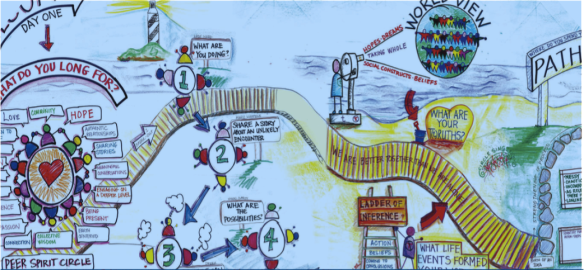 The chaordic stepping stones provide a powerful planning framework for small initiatives and for large comprehensive projects but there is very little that has been written about them to illustrate how they work together. Jerry and I use them explicitly and implicitly in our work. I was recently involved with a school review process for the Halifax School Board that provides a lovely simple example to demonstrate the chaordic stepping stones at work.
The chaordic stepping stones provide a powerful planning framework for small initiatives and for large comprehensive projects but there is very little that has been written about them to illustrate how they work together. Jerry and I use them explicitly and implicitly in our work. I was recently involved with a school review process for the Halifax School Board that provides a lovely simple example to demonstrate the chaordic stepping stones at work.
The stepping stones are: need, purpose, principles, people, concept, limiting beliefs, structure, act/practice and harvest. We often describe purpose as the invisible leader and describe this process as being front-end loaded as it can take a bit of time and conversation to get to clarity.
In 2016, the Halifax School Board changed its approach to community consultation for school review processes. Shape Shift Strategies Inc. provided hosting support for the first completed review process, called historic by a member of the school board, using a new approach.
Need
Need is the compelling reason for doing anything. Sensing the need is the first step to designing a meeting, organizational structure or change initiative that is relevant to the people and organizations involved.
In this example, in the previous 18 months, a boundary review had been completed for Eastern Passage and the neighbouring school district and a decision had been made to build a new high school for the Eastern Passage Family of Schools. When the new high school is built it will be configured for grades 9-12, removing the grade 9’s from one of the existing schools. There are four affected schools in the Eastern Passage area with varying degrees of utilization of the buildings, from greatly underutilized to having a portable classroom due to over utilization.
There was a need to look at utilization of the schools and grade configurations to look for more optimal usage across the schools.
Purpose
Purpose flows from need and guides the way for the best possible work to be done. Achieving clarity on purpose can at times be challenging but well worth it and, from any need, multiple purposes could flow.
In this case, a School Options Committee (SOC) was appointed by the School Board and the purpose of its work was to design a process for community input into the decision making process around grade configurations and school utilization, to identify options for consideration by the community and to offer a recommendation to the school board.
Principles
The SOC operated with several principles. Some of them were with respect to the operation of the committee and some were to guide decision making.
Two of the principles: operate with shared responsibility and shared leadership. Among other things, it meant that the SOC did not appoint or nominate a chair of the committee. It also meant that every member of the SOC who wanted to would be part of presenting and hosting at each of the community engagement sessions. This carried right through to presenting the final recommendation to the school board. Although we were informed that one person could present to the school board, as one member of the committee said, “We don’t roll that way.”
There were also a number of principles that guided decision making for the recommendation. There were two that were primary. They were: more optimal usage of each of the affected schools and minimal disruption to students and the community. There were some options considered – like creating a French only school and making each school a Primary to Grade 5 school that could provide good utilization of buildings but would have caused disruption across the community. The final decision involved a boundary change that directly affected only 30 families.
Another principle that guided decision making is that the process would be informed by data and by knowledge available through school board resources.
People
“If it is about us, don’t do it without us.”
 There were a number of different groupings of people the SOC needed to be mindful about including in the process. It started with the SOC itself being representative of the four schools under review. Parents, students, staff of the schools were all invited to be part of the process. The SOC used a variety of means to try to ensure that the community was aware of the process and had an opportunity to contribute, whether it was in the community consultations or through email or social media.
There were a number of different groupings of people the SOC needed to be mindful about including in the process. It started with the SOC itself being representative of the four schools under review. Parents, students, staff of the schools were all invited to be part of the process. The SOC used a variety of means to try to ensure that the community was aware of the process and had an opportunity to contribute, whether it was in the community consultations or through email or social media.
Children were welcome, a principle not widely known for the first consultation and so a few parents stayed home. When they were encouraged to come and bring their children with them, they did.
Concept
The higher level concept for the review was a process that had been decided in a province wide policy. There would be a community process and it would include three engagement sessions. The first was to inform the public about the new process. The second was to offer options and the third was to present a recommendation. The structure of those community gatherings was not predetermined, nor was the format for the SOC meetings.
Limiting Beliefs
There were an interesting array of limiting beliefs that showed up throughout the process, often both in the committee and the community. A few of them were:
- A belief or concern that the school board actually had it all figured out and had already made a decision
- The sentiment that one of the four schools was the best one.
- Additionally, this “best” school houses the French Immersion program and there was a belief that out of area parents sent their kids to French Immersion so they could be in that school
Structure
Once the concept has been chosen, it is time to create the structure that will channel resources. It is in these conversations that decisions about the resources of the group: time, money, energy, commitment and attention are made.
The design for each of the community consultations was different. The first one used a world café format to introduce the process and ask parents what was working that they wanted to see continued in the schools and anything else they wanted the SOC to consider as options were being discussed. The second community meeting used a modified form of open space technology as each of the options were set up as an “options station” and parents could visit each of the options and provide their thoughts and questions. The final one took the form of a presentation and then a “round robin” conversation, ensuring that the variety of perspectives in the room could be heard.

Act/Practice
The ongoing practice within the structures agreed upon and designed is important. This is the world of to do lists, conference calls and e-mail exchanges. The invitation here is to practice working with one another in alignment with the designs created.
The SOC had regular meetings usually intended to last two hours. Notes were taken, community consultation designs were created and many hours were consumed in becoming informed about decision making criteria, data and other things relevant to make data informed sound decisions about school configurations. The SOC also had a check-in and check-out practice for each of its meetings.
Harvest
Harvesting is about making meaning of the work, telling the story and feeding forward the results so that they have the desired or intended impacts in the world.
It was decided early on that graphic facilitation would be part of the overall harvest and Susan MacLeod did an awe inspiring job of this. The graphic facilitation work was included in each report as well as used as part of a slide presentation bridging community consultation 1 and 2.
Reports were created for each community consultation. Short evaluations were completed, compiled and shared for each community consultation. Meeting notes were posted for the committee but also for the school board and community to view. A final recommendation was completed as well. These are all forms of harvesting used throughout this process.
Iterative Process
Working with the chaordic stepping stones provides an iterative planning framework and process that has participants continuing to check back with each of the stepping stones as plans and implementation emerges and changes. Are we still working to need and purpose? Do we have all the right people given where we are in our process? Are there new limiting beliefs that have emerged? Does our design still work? How do we continue to make meaning of our experiences? Has the need changed now that we have been doing some of the work? Are our principles holding strong?
Where are you in your process?


 The chaordic stepping stones provide a powerful planning framework for
The chaordic stepping stones provide a powerful planning framework for  There were a number of different groupings of people the SOC needed to be mindful about including in the process. It started with the SOC itself being representative of the four schools under review. Parents, students, staff of the schools were all invited to be part of the process. The SOC used a variety of means to try to ensure that the community was aware of the process and had an opportunity to contribute, whether it was in the community consultations or through email or social media.
There were a number of different groupings of people the SOC needed to be mindful about including in the process. It started with the SOC itself being representative of the four schools under review. Parents, students, staff of the schools were all invited to be part of the process. The SOC used a variety of means to try to ensure that the community was aware of the process and had an opportunity to contribute, whether it was in the community consultations or through email or social media.


 After she left, I found myself at times
After she left, I found myself at times 




 And it has inspired both of them to be on the calling team for an Art of Hosting offering in Philadelphia in February 2016 called
And it has inspired both of them to be on the calling team for an Art of Hosting offering in Philadelphia in February 2016 called 








 You may like to draw on a pattern like
You may like to draw on a pattern like